Несмотря на то, что в Windows 11 нет встроенного интерфейса просмотра индекса производительности системы, который присутствовал в «семёрке», инструменты оценки всё ещё присутствуют в системе и дают нам возможность узнать результат.
В этой простой инструкции способы посмотреть индекс производительности системы Windows 11 используя лишь встроенные средства ОС или с помощью простой сторонней утилиты. Учитывайте, что относиться к вычисленному индексу серьёзно и делать какие-то выводы на его основе не стоит.
Запуск анализа производительности
Прежде чем мы сможем узнать индекс производительности системы, потребуется запустить встроенный тест: если ранее он выполнялся автоматически, то в Windows 11 это может не происходить.
Для выполнения анализа используйте следующие шаги:
- Запустите командную строку, лучше (но не обязательно) сделать это от имени администратора, подробнее: Как запустить командную строку от имени администратора в Windows 11. В Windows PowerShell команда также будет исправно работать.
- Введите команду
winsat formal -restart clean
и нажмите Enter.
- Дождитесь завершения оценки производительности системы.
Теперь в файлах системы будут сохранены данные проведённого встроенного теста, на основании которого и высчитывается индекс производительности системы, а у пользователя есть возможность посмотреть полученные результаты.
Узнаем индекс производительности Windows 11
Для того, чтобы узнать вычисленный индекс производительности системы можно использовать несколько способов.
Просмотр средствами системы
Первый, не предполагающий использования каких-либо сторонних инструментов — команда PowerShell:
- Запустите Windows PowerShell. Можно использовать поиск в панели задач, а можно нажать правой кнопкой по кнопке «Пуск» и открыть «Терминал Windows», по умолчанию в нём открывается окно PowerShell.
- Введите команду
Get-CimInstance Win32_WinSAT
- После выполнения команды вы получите список рассчитанных индикаторов производительности. Наименьшее из значений (без учета пункта WinSATAssesmentState) и будет индексом производительности, оно же отображается в пункте WinSPRLevel.
Перевод каждого из пунктов в отчёте в соответствии с тем, как они были представлены в предыдущих версиях системы:
- CPUScore — процессор
- D3DScore — графика для игр и 3D приложений (на современных системах почти всегда максимум, независимо от видеокарты)
- DiskScore — производительность диска HDD или SSD
- GraphicsScore — графика рабочего стола
- MemoryScore — оперативная память
Эти же данные можно посмотреть вручную, заглянув в папку
C:\Windows\Performance\WinSAT\DataStore
и открыв файл
Formal.Assessment (Recent).WinSAT.xml
с помощью любого текстового редактора или браузера.

Внутри этого xml-файла в разделе WinSPR представлены все указанные данные, а общий индекс производительности виден в разделе SystemScore.
Утилита Winaero WEI Tool
Небольшая сторонняя бесплатная программа позволяет посмотреть индекс производительности Windows 11 в более знакомом графическом интерфейсе: данные она берёт из того же системного файла, а при желании, с помощью этой же программы можно перезапустить тест производительности (Re-run the assessment).

Официальная страница, где можно скачать Winaero WEI Tool — https://winaero.com/download-winaero-wei-tool/ (будьте внимательны, текстовая ссылка на загрузку находится ближе к концу страницы).
Видео инструкция
Напомню то, о чём уже шла речь выше: полученный индекс производительности системы производится по шкале, которой уже много лет, и может быть не вполне объективным для современных систем.
В Windows 8.1 разработчики Microsoft решили скрыть встроенный бенчмарк «Индекс производительности», так как он оказался невостребованным пользователями. Удалять его полностью, однако, разработчики не стали, посчитав, что он ещё может пригодиться тестировщикам и системным администраторам. С того времени ничего не изменилось, и «Индекс производительности» по-прежнему остаётся доступным в Windows, включая последнюю версию операционной системы. Что же, давайте посмотрим, как в новой Windows 11 можно просмотреть показатели этого компонента.
{banner_google1}
Для получения индекса производительности в Windows 11 можно воспользоваться консолью PowerShell. Запустите через меню Win + X Терминал, лучше всего от имени администратора и выполните в нём (вкладка PowerShell открывается по умолчанию) команду Get-CimInstance Win32_WinSAT.

В результате в прямо в консоль будут выведены следующие данные:
• CPUScore — индикатор производительности процессора
• D3DScore — индикатор производительности графики для игр и 3D-программ.
• DiskScore — индикатор производительности жёсткого диска.
• GraphicsScore — индикатор производительности графики рабочего стола.
• MemoryScore — индикатор производительности оперативной памяти.
• WinSPRLevel — средний индекс производительности, как раз то, что и нужно было получить.
Данные индекса производительности хранятся в особом XML-файле Formal.Assessment (Initial).WinSAT, располагающемся в папке C:\Windows\Performance\WinSAT\DataStore.
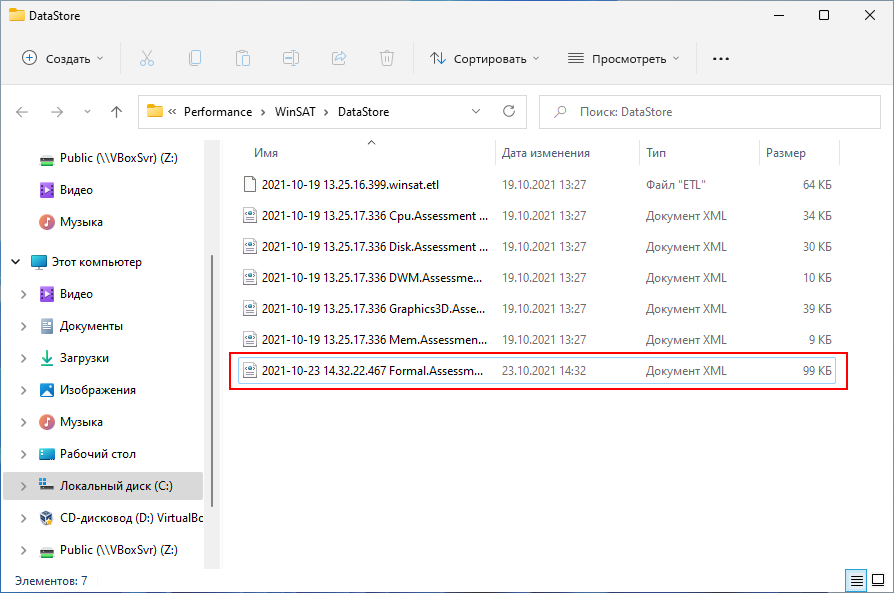
{banner_google1}
Если в указанном расположении файл отсутствует, его нужно будет сгенерировать командой winsat formal, выполненной в запущенном от имени администратора Терминале Windows 11.
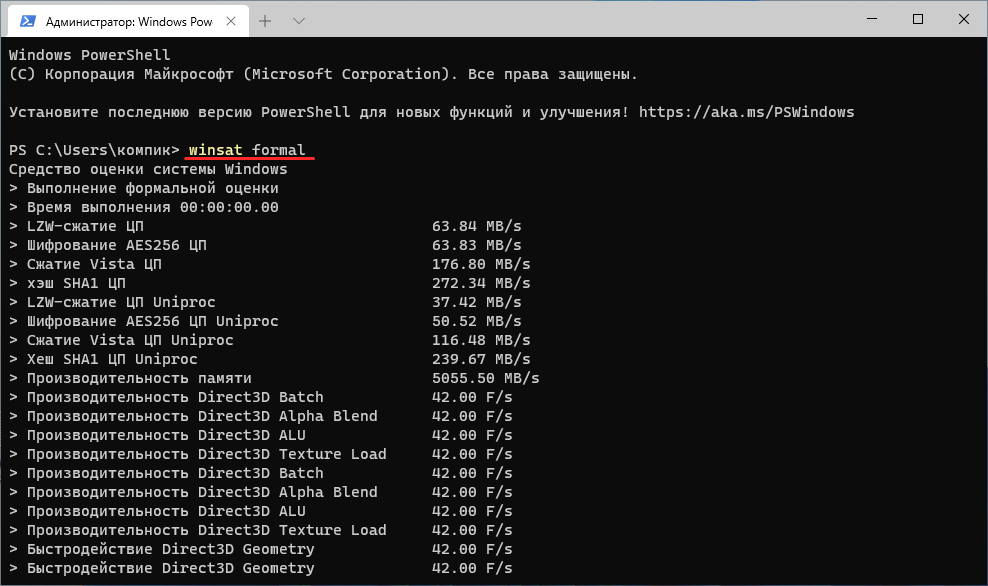
После того как команда отработает, закройте консоль, перейдите в папку с отчётом и откройте приложением по умолчанию. В качестве последнего Windows 11 предлагает использовать браузер. Обратите внимание на содержимое тега WinSPR (он находится вначале файла), значение индекса производительности будет указано во вложенных тегах SystemScore.
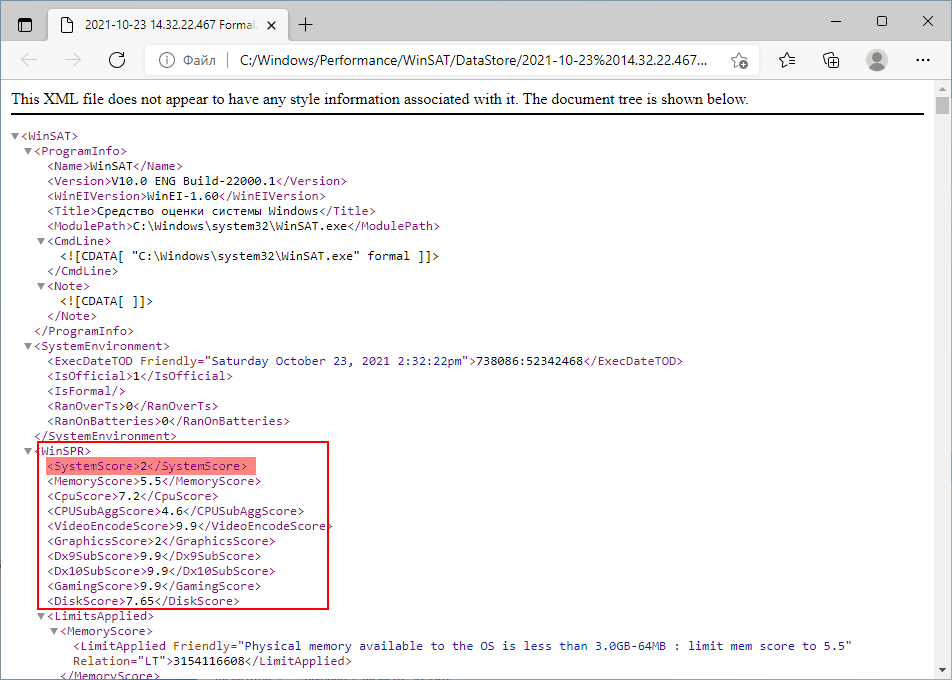
Наконец, для получения индекса производительности в Windows 11 вы можете воспользоваться бесплатной портативной утилитой WEI Tool. Эта тулза считывает данные файла Formal.Assessment (Initial).WinSAT и выводит их в своём окне в наглядном удобочитаемом виде. Если файл отсутствует, утилита покажет индекс производительности 0.0, что понятно, так как данные брать неоткуда. В этом случае выполняем оценку производительности нажатием в окне WEI Tool ссылки «Re-run the assessment», что соответствует выполнению команды winsat formal.
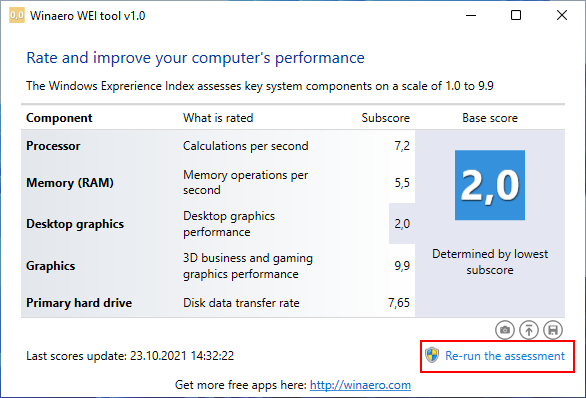
WEI Tool — не единственный сторонний инструмент для получения индекса производительности в Windows 8.1, 10 и 11, есть ещё такая утилита как ExperienceIndexOK, работающая по тому же принципу, что и WEI Tool.
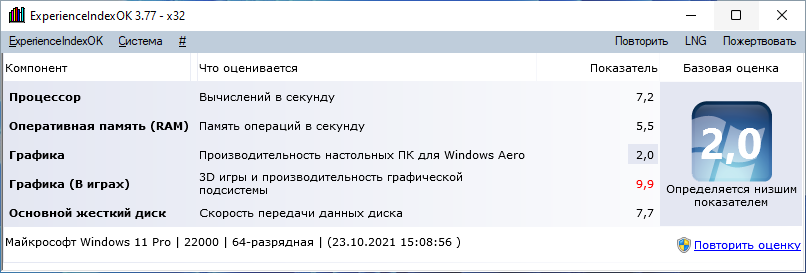
А вообще, придавать особое значение индексу произвольности, полученному средствами Windows, не стоит: они слишком поверхностные и слишком общие, чтобы на их основании делать какие-то выводы.
Windows 11 is the latest version of Windows that has been released by Microsoft. It comes with several exciting features, and it is meant to provide a seamless user experience. However, some users might experience lag and slow performance when using it. This is where checking your computer speed comes in.
Checking your computer speed helps you determine the factors that contribute to its slow performance. It helps you identify whether it’s a hardware or software issue, and you can then take the necessary steps to rectify the situation. In this article, we will look at four methods that you can use to check your computer speed in Windows 11.
Video Tutorial:
What’s Needed
To check your computer speed in Windows 11, you need the following:
– A Windows 11 computer
– Internet connectivity
– Keyboard and mouse or touchpad
What Requires Your Focus?
When checking your computer speed in Windows 11, you need to focus on the following:
1. Start with the basics: Ensure that your computer is not overheating, and that all the cables and wires are properly connected.
2. Identify the possible causes of slow performance: This could be due to malware, outdated drivers, insufficient RAM, or outdated software.
3. Determine which method to use: There are several methods that you can use to check your computer speed in Windows 11, and you need to choose the most appropriate one based on your situation.
Here are four methods that you can use to check your computer speed in Windows 11:
Method 1: Using Windows Task Manager
Windows Task Manager is a built-in utility in Windows computers that lets you monitor the performance of your computer. Here’s how to use it:
1. Press Ctrl + Shift + Esc to open Task Manager.
2. Click on the Performance tab.
3. You will see a graph that shows you the usage of your CPU, Memory, Disk, and Wi-Fi. This will give you an idea of which component is causing your computer to slow down.
4. Click on the Details tab to see which processes are using up your CPU and memory the most.
Pros:
– It’s already built-in in Windows 11
– It’s straightforward to use
Cons:
– It doesn’t give you an in-depth analysis of your computer speed
– It doesn’t provide you with a benchmark score
Method 2: Using Windows Performance Monitor
Windows Performance Monitor is a more advanced tool that provides an in-depth analysis of your computer’s performance. Here’s how to use it:
1. Type «Performance Monitor» in the search bar and click on it.
2. Click on «+» to add counters.
3. Select the counter category you want to add. For example, «Memory» or «CPU.«
4. Select the specific counter you want to monitor. For example, «Available MBytes» or «% Processor Time.«
5. Click on «Add» and repeat steps 3-5 for other categories/counters that you want to monitor.
6. After adding all the counters you want, click on «OK.«
7. Wait for the Performance Monitor to gather data.
8. You can then analyze the data and identify which component is causing your computer to slow down.
Pros:
– Provides an in-depth analysis of your computer speed
– You can customize which counters to monitor
Cons:
– It can be overwhelming for beginners
– You need to have an understanding of system performance counters
Method 3: Using UserBenchmark
UserBenchmark is a third-party software that tests the performance of your computer against other similar systems. Here’s how to use it:
1. Download and install UserBenchmark.
2. Run the program and click on «Run.«
3. Wait for the benchmark process to complete.
4. You will then be provided with a performance score for your computer, and you can compare it with other similar systems.
Pros:
– Provides an objective benchmark score
– Easy to use
Cons:
– It can be time-consuming
– It doesn’t provide any in-depth analysis
Method 4: Using PassMark PerformanceTest
PassMark PerformanceTest is another third-party software that provides an in-depth analysis of your computer’s performance and an objective benchmark score. Here’s how to use it:
1. Download and install PassMark PerformanceTest.
2. Run the program and click on «Run Benchmark.«
3. Wait for the benchmark process to complete.
4. You will then be provided with a performance score for your computer, and you can compare it with other similar systems.
Pros:
– Provides an objective benchmark score
– Provides an in-depth analysis of your computer’s performance
Cons:
– It’s not a free software
– It can take some time to complete the benchmark process
Why Can’t I Check My Computer Speed In Windows 11?
There are several reasons why you might not be able to check your computer speed in Windows 11:
1. Malware: Malware can significantly slow down your computer’s performance, and it might prevent you from using certain tools to check your speed.
2. Incompatible software: Some software might not be compatible with Windows 11, and attempting to run it might cause your computer to crash or freeze.
3. Hardware issues: If your computer’s hardware is damaged or faulty, it might prevent you from using certain tools to check your speed.
Fixes:
1. Scan your computer for malware and remove any threats that are found.
2. Ensure that all your software is up-to-date and compatible with Windows 11.
3. Check your computer’s hardware components to ensure that they are functioning correctly.
Implications and Recommendations
Checking your computer speed is an essential task that helps you identify the factors that contribute to its slow performance. By using one of the methods discussed in this article, you can determine whether your computer is experiencing a hardware or software issue, and you can then take the necessary steps to rectify it.
Some recommendations for maintaining your computer speed include:
1. Regularly scan your computer for malware and remove any threats that are found.
2. Keep your software up-to-date and ensure that it’s compatible with Windows 11.
3. Regularly clean your computer’s hardware components to prevent dust and debris from affecting their performance.
FAQs
Q: Can I check my computer speed using an online tool?
A: Yes, there are several online tools that you can use to check your computer speed. Some popular ones include Speedtest.net and Fast.com.
Q: What should I do if my computer speed is slow?
A: You can try the following steps to improve your computer’s speed:
– Uninstall any unnecessary software
– Perform a disk cleanup
– Increase your computer’s RAM
– Upgrade your hard drive to an SSD
Q: How often should I check my computer speed?
A: It’s recommended that you check your computer speed at least once every three to six months. This helps you identify any issues before they become more significant problems.
Q: Will checking my computer speed affect my computer’s performance?
A: No, checking your computer speed should not affect your computer’s performance. It’s a passive task that runs in the background and does not require a lot of resources.
Q: How can I prevent my computer from overheating?
A: You can prevent your computer from overheating by doing the following:
– Ensure that it’s placed on a flat and stable surface
– Keep it in a well-ventilated area
– Use a cooling pad or a fan to dissipate heat
– Clean the dust and debris from your computer’s fans and heatsinks regularly
In Conclusion
Checking your computer speed is an essential task that helps you identify the factors that contribute to its slow performance. By using the methods discussed in this article, you can determine whether your computer is experiencing a hardware or software issue, and you can then take the necessary steps to rectify it. Remember to regularly scan your computer for malware, keep your software up-to-date, and ensure that your computer’s hardware components are functioning correctly to maintain its speed.
-
Home
-
News
- [9 Methods] How to Open Windows 11 Performance Monitor Quickly?
By Helen | Follow |
Last Updated
This post summarized by MiniTool Software Ltd. focuses on the system performance monitor tool in Win11. It introduces altogether nine ways to start Windows 11 Performance Monitor for you to choose from. Continue reading to find what are they.
What Is Windows 11 Performance Monitor?
Performance Monitor is an operating system (OS) monitoring program introduced in Windows NT 3.1. It is also known as System Monitor in Windows XP, Windows 2000, and Windows 9x (e.g. Windows 98 and Windows 95).
Performance Monitor monitors various activities on the PC like memory usage and CPU behavior. It may be used to determine the cause of problems on a local or remote computer by measuring the performance of hardware, software, as well as apps.
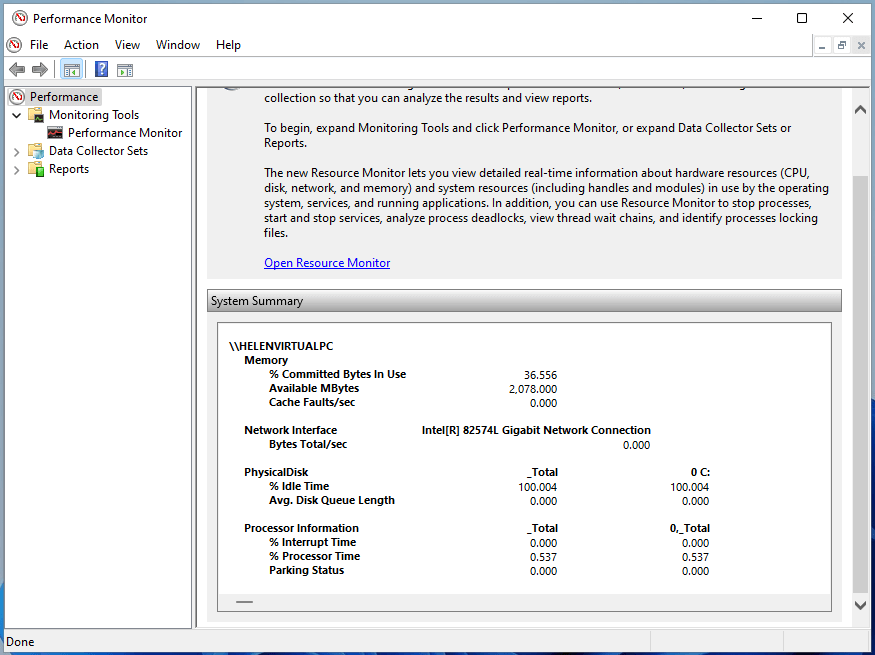
Windows 11 Performance Monitor refers to the OS monitor in the newest Windows 11. Here, we will teach you several ways to launch Performance Monitor in Windows 11.
Way 1. Open Windows 11 Performance Monitor Through Search
Firstly, you can access Windows 11 Performance Monitor relying on the Windows Search feature. Just click on the magnifier on the taskbar and type “performance monitor” or “perfmon” in the search bar. Then, find and click to open the best result.
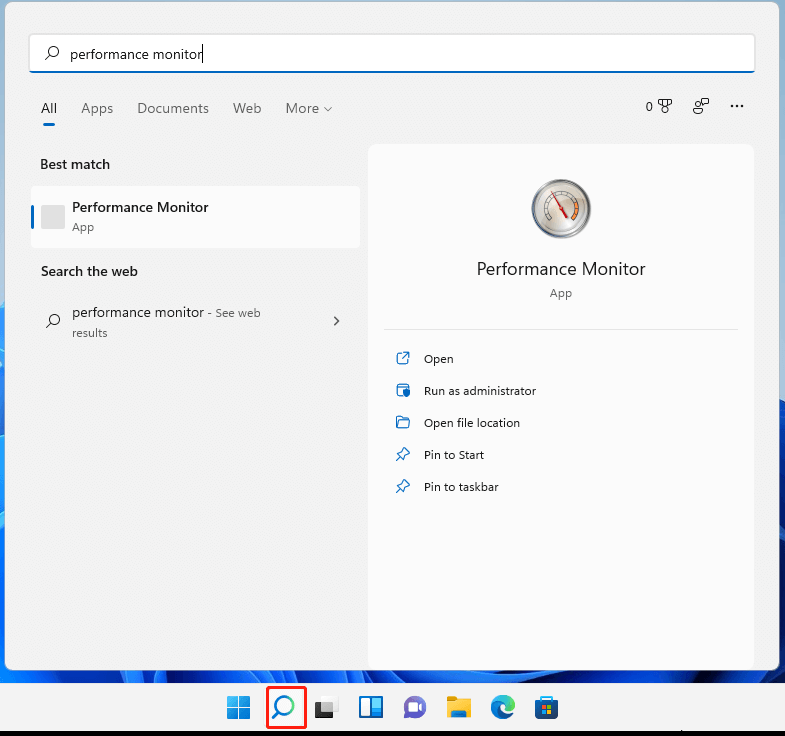
Way 2. Launch Windows 11 Performance Monitor via Task Manager
Search and open Task Manager from Windows Search. Then, click File > Run new task. In the new popup, input “perfmon” and click OK to get Performance Monitor.
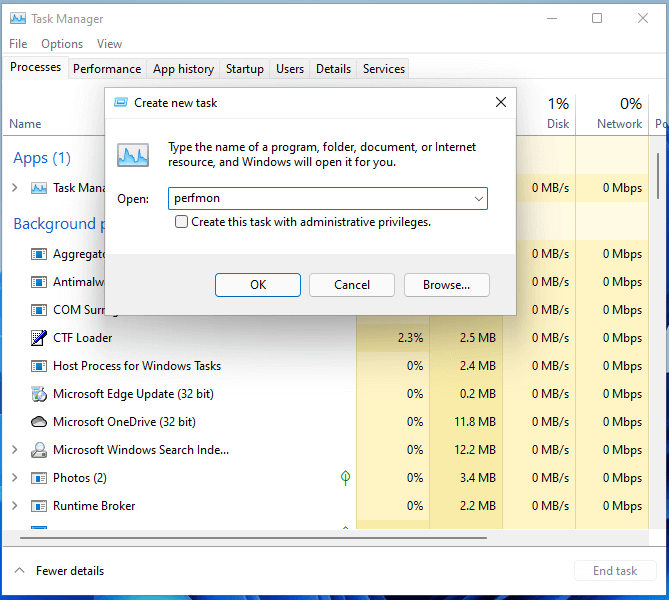
You can also reach the Performance Monitor from the Windows Tools. Click on the Start Menu and select All Apps. Then, scroll down to find Windows Tools and unfold it. In the Windows Tools window, find and click Performance Monitor to open it.
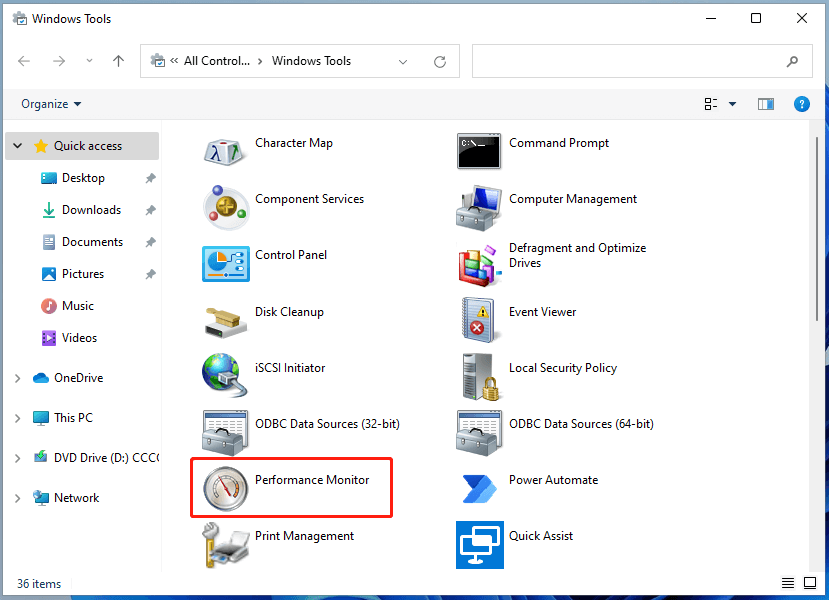
Way 4. Pin Windows 11 Performance Monitor to Start/Taskbar for Quick Access
If you use Windows Performance Monitor frequently, you can consider pinning it to your Start Menu or taskbar for quick access. The process is not complicated. Just search “performance monitor” in Windows Search. Then, right-click on the best result and choose Pin to Start or Pin to taskbar.
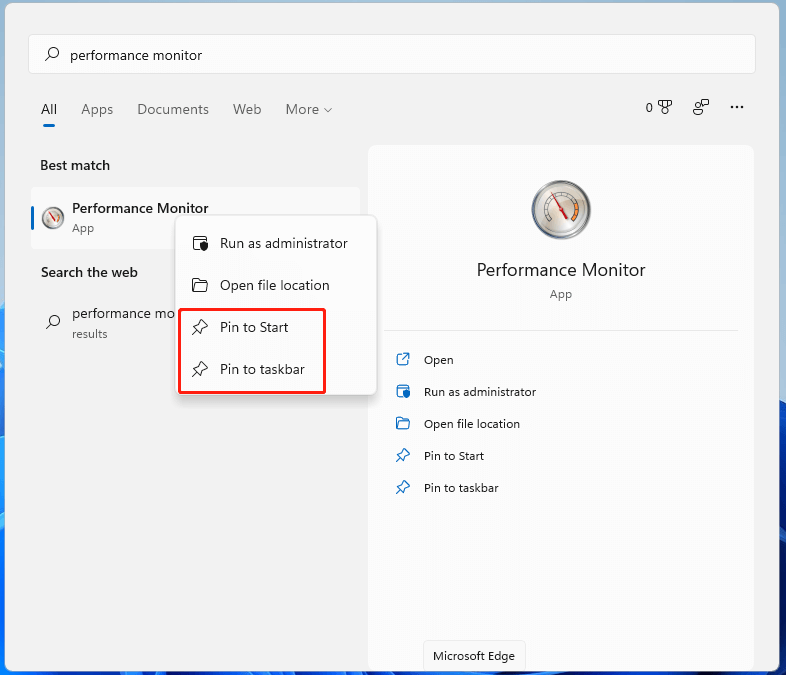
Way 5. Open Performance Monitor in Windows 11 Using Shortcut
Similarly, you can create a desktop shortcut for Performance Monitor to use it often. Right-click on your Desktop and choose New > Shortcut. Then, input “perfmon” and click Next > Finish.
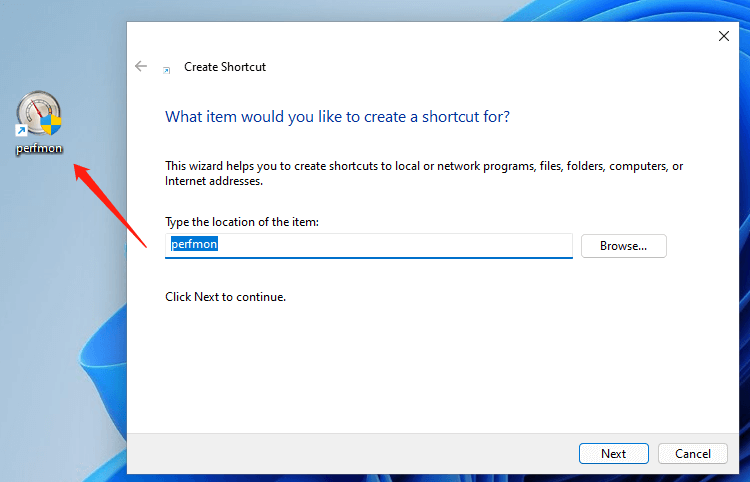
Way 6. Access Windows 11 Performance Monitor from Computer Management
Next, you are able to arrive at the Performance Monitor program within Computer Management. Search and open Computer Management in Windows Search. Then, in the Computer Management window, click on Performance to use the system monitoring function.
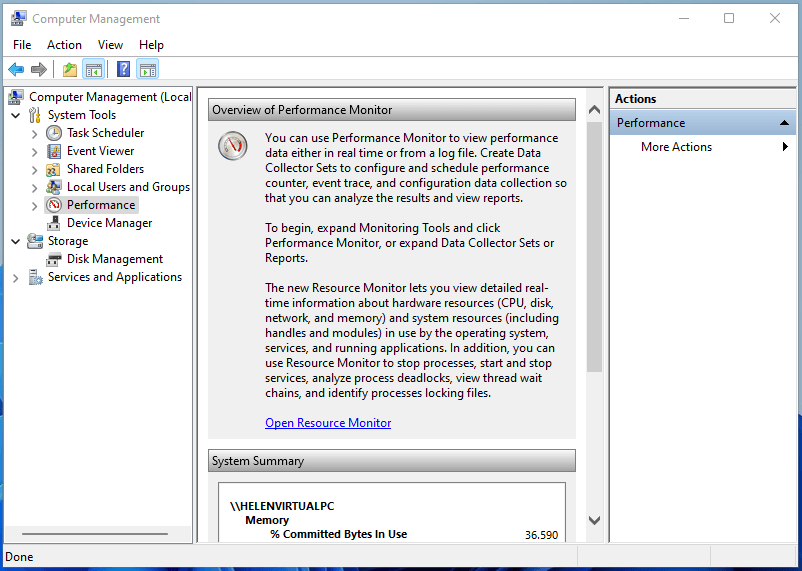
Way 7. Reach Windows 11 Performance Monitor by System Configuration
Search “system configuration” in Windows 11 Search and open it. In the pop-up System Configuration window, navigate to the Tools tab. There, find and click on the Performance Monitor item and click on the Launch button.
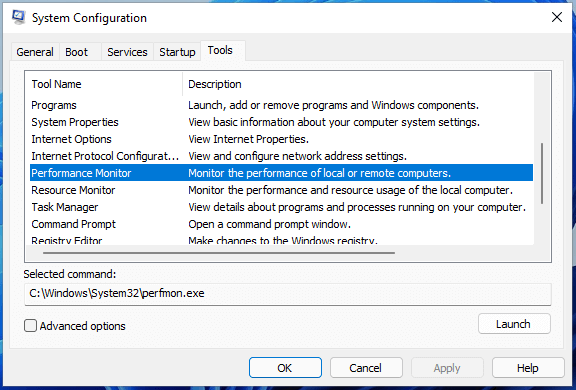
Way 8. Open Windows 11 Performance Monitor Within File Explorer
Search “perfmon” within the Windows File Explorer. Find and open the best match. Or, you can directly find the location of perfmon file, usually located in C:\Windows\System32, and double-click to launch it.
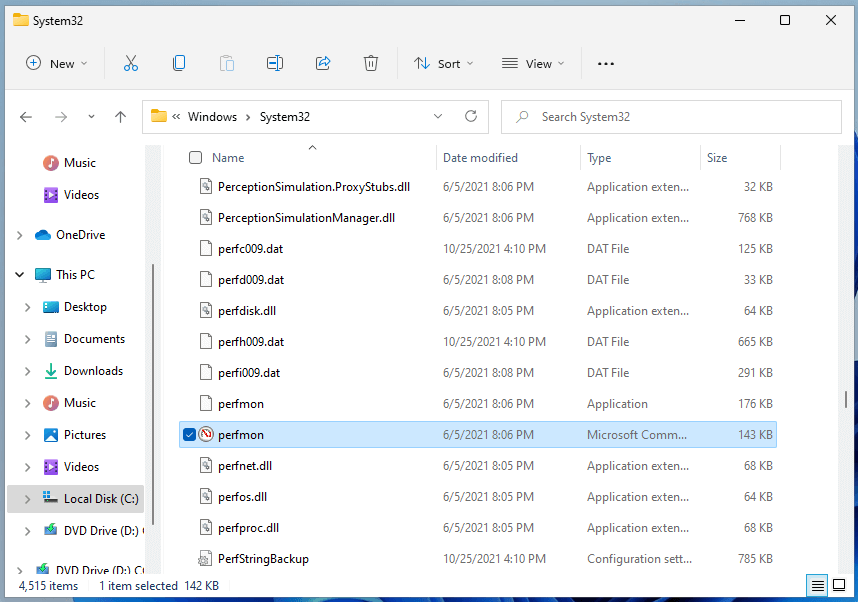
Way 9. Trigger Windows 11 Performance Monitor Relying on Command
Finally, you can get Windows 11 Performance Monitor with the help of command. Open one of the three command platforms, Run box, CMD, or PowerShell, and type “perfmon”, “perfmon.exe”, or “perfmon.msc” and press Enter to finish.
Windows 11 Assistant Software Recommended
The new and powerful Windows 11 will bring you many benefits. At the same time, it will also bring you some unexpected damages such as data loss. Thus, it is strongly recommended that you back up your crucial files before or after upgrading to Win11 with a robust and reliable program like MiniTool ShadowMaker, which will assist you to protect your increasing data automatically on schedules!
MiniTool ShadowMaker TrialClick to Download100%Clean & Safe
Read more
- 5 Simplified Ways to Open Windows 11 Registry Editor – Tested!
- 7 Ways: How to Open Windows 11 Group Policy Editor Step-by-Step?
- [Graphic Guide] How to Open Windows 11 Event Viewer in 7 Methods?
About The Author
Position: Columnist
Helen Graduated from university in 2014 and started working as a tech editor in the same year. Her articles focus on data backup & recovery and disk management. Through an in-depth exploration of computer technology, Helen has successfully helped thousands of users solve their annoying problems.


